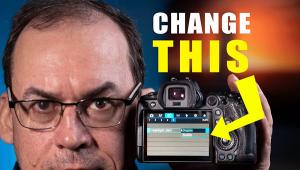This Pro Says Raising ISO Will Help You Take Better Outdoor Photos (VIDEO)

Conventional wisdom has it that we should always shoot at the lowest ISO setting permitted by the situation at hand. But as you can see from the quote in the lead photo above, some pros beg to disagree. In the interesting tutorial below, you'll learn three reasons why increasing ISO settings can actually help you capture better images.
British landscape photographer Ian Worth has been a full-time pro for over a decade, so when he urges you to "stop shooting at ISO 100," there plenty of experience backing up that advice. He's also somewhat of a contrarian who regularly posts tutorials that reveal simple pro tricks (like you'll find here) that amateurs who pay attention to the "rules" often ignore."
In this behind-the-scenes lesson you'll watch Worth visit a stunning coastal location while discussing ways to modify ISO settings to open up a new world of photographic opportunities. He begins by explaining how he prefers to shoot: "I never even consider what my ISO value is unless it gets above 6,400." He also reveals that he typically shoots in Aperture Priority mode, and never lets his shutter speed drop below 1/100.

Interestingly, especially for a pro with a portfolio of great images, he adds that "I let Auto ISO take care of the rest." So much for the "purists" who insist that you're not a real photographer unless you shoot in Manual mode.
Worth defends the above approach like this: "I can control my exposure with the EV-Compensation dial. It's such a quick and simple way of allowing me to take photos and concentrate on what's happening around me."
The first situation in which Worth recommends bumping up ISO is when you're shooting hand-held. Here, Worth's rationale is obvious: avoiding camera shake. As he says, "Camera shake will ruin an image to the point of no repair." So how about setting up a tripod? Worth insists that doing so could make him miss a fleeting moment of spectacular light.

As the video continues, you'll watch Worth capture some nice image as various ISO settings—in both color and b&w—so you can compare them and decide for yourself. There's also a quick discussion regarding the ramifications of shooting at base ISO.
Worth also demonstrates how to use ISO to freeze motion, as well as how to control it to suit his creative vision. Be sure to watch until the end, because he offers a bonus tip about what he calls "ISO invariant cameras."
There's much more to learn on Worth's instructional YouTube channel, so be sure to take a look.
And don't miss another tutorial we posted recently, explaining five more pro techniques for shooting amazing landscape nature photos.















































